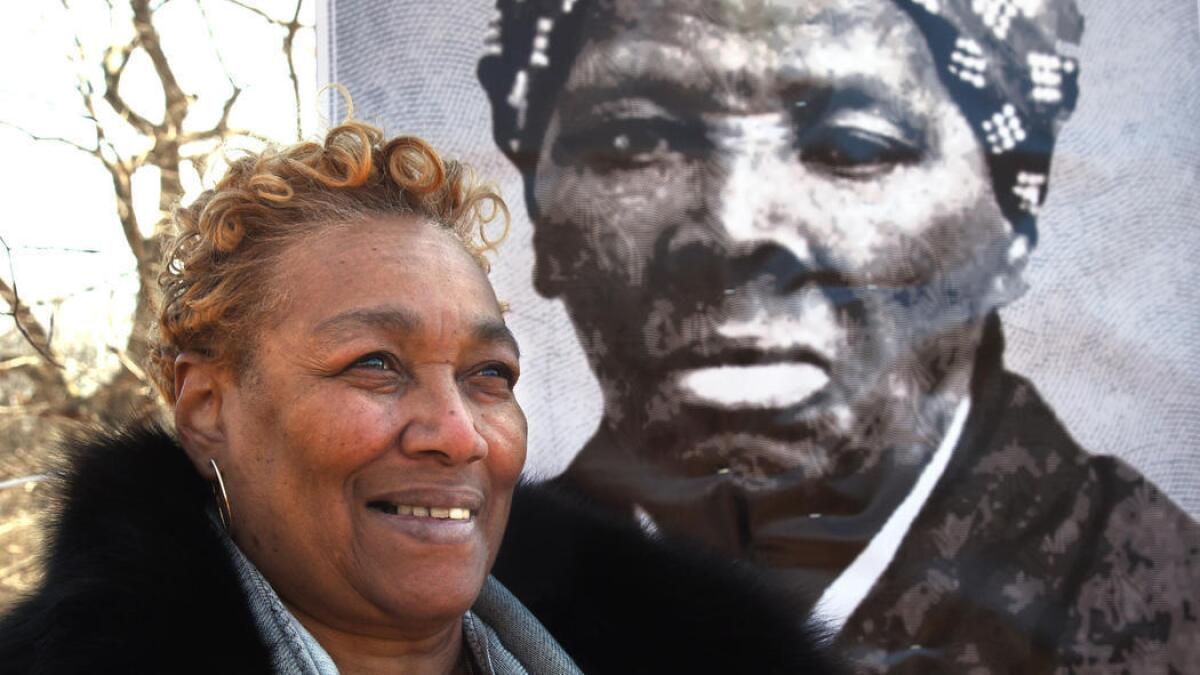Baltimore park space once venerated Confederate generals. Now it honors Harriet Tubman

- Share via
Reporting from BALTIMORE — More than 200 residents and elected leaders gathered in a tree-lined corner of a Baltimore park Saturday to rededicate the space, which had long venerated two Confederate generals, to the famed abolitionist and Underground Railroad conductor Harriet Tubman.
“We stand on the shoulders of this great woman,” said Ernestine Jones-Williams, 71, a Baltimore County resident and a Tubman family descendant who spoke on behalf of the family. “We are overwhelmed. Overwhelmed. Thank you, and God bless you.”
The ceremony in Wyman Park Dell, on the 105th anniversary of Tubman’s death, took place feet from the now-empty pedestal of a large, bronze, double-equestrian statue of Confederate Gens. Robert E. Lee and Stonewall Jackson, and officially renamed the space Harriet Tubman Grove.
The statue had stood in the park since 1948, but was removed in August amid a national debate over Confederate symbolism and monuments, and how they are viewed by those who see them as offensive reminders of the country’s racial history and those who proudly consider them a part of their Southern heritage.
The public reckoning over the placement and meaning of such statues in public spaces, began in large part in 2015, after white supremacist Dylann Roof shot nine African Americans to death in a church in Charleston, S.C. It grew in August after a violent white supremacist rally to protest the planned removal of a statue of Lee in Charlottesville, Va., led to the death of a counter-protester.
Mayor Catherine Pugh’s administration removed four Baltimore monuments with ties to the Confederacy days after the Charlottesville rally in an unannounced, overnight operation, citing “safety and security” concerns. The four were the Lee-Jackson monument, a monument to Supreme Court Chief Justice Roger B. Taney, the Confederate Soldiers and Sailors Monument and the Confederate Women’s Monument.
At the event Saturday, city officials and local residents cited the events in Charleston and Charlottesville, but largely focused on more local efforts to have Baltimore’s statues removed, including a grass-roots petition drive.
They said the removal of the statues has imbued the spaces where they once stood, such as the Harriet Tubman Grove, with their own symbolic power.
“Since the removal of the Lee-Jackson statue, this park has become a gathering place for city residents of all backgrounds to meet, talk and enjoy the location as a space that symbolizes hope and positive change,” said Ciara Harris, chief of staff to Baltimore Recreation and Parks Director Reginald Moore. “Harriet Tubman Grove will provide the city an opportunity to correct historic injustice to a Maryland native. Our city is properly recognizing an African American hero.”
City Councilwoman Mary Pat Clarke called Tubman, who was born a slave on Maryland’s Eastern Shore but went on to lead many other enslaved people to freedom along the Underground Railroad, a “heroine and beacon for all ages.”

Marvin “Doc” Cheatham, a longtime local civil rights leader who has been working to get Tubman recognized in more official ways across the city for years, thanked the community for its work in renaming the grove.
“You did what needed to be done to say, ‘Yes, we need to move on,’ ” he said.
Jackson Gilman-Forlini, 28, who is studying how society re-contextualizes monuments and memorials over time as part of a master’s degree program in historic preservation at Goucher College, said the rededication was a great thing for the city. He served on the task force formed by Pugh last year to study the removal of the city’s Confederate monuments.
“Monuments are seen as permanent, sort of monolithic structures, but inherently their meanings change over time, and really the removal of these monuments was not so much about monuments in general, but about the kind of values that we as a society want to promote,” said Gilman-Forlini, who also works for the city as a historic preservationist. “This is now the next logical step in the process of asserting those values, those positive values of inclusion, of tolerance, of speaking out against prejudice.
“These kind of gatherings in many ways are much more powerful than new monuments may necessarily be, because these are about community action and about the experience of the individual working in a community to assert positive values,” he said. “In that way I think this is really the best thing that we could be doing right now as a means of healing past injustices.”
Rector writes for the Baltimore Sun.
More to Read
Sign up for Essential California
The most important California stories and recommendations in your inbox every morning.
You may occasionally receive promotional content from the Los Angeles Times.













